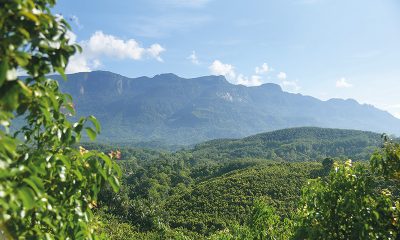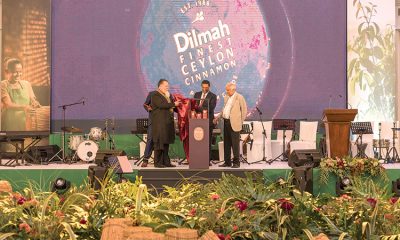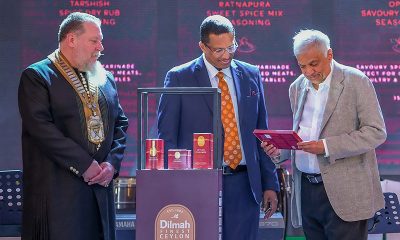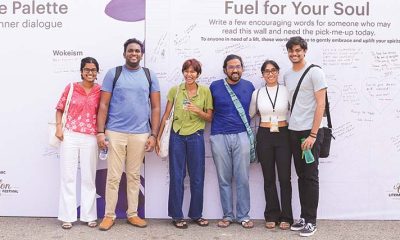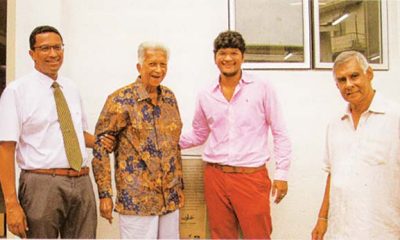Features
Fighting off attempts to hobble me and making the Dilmah mark in New Zealand
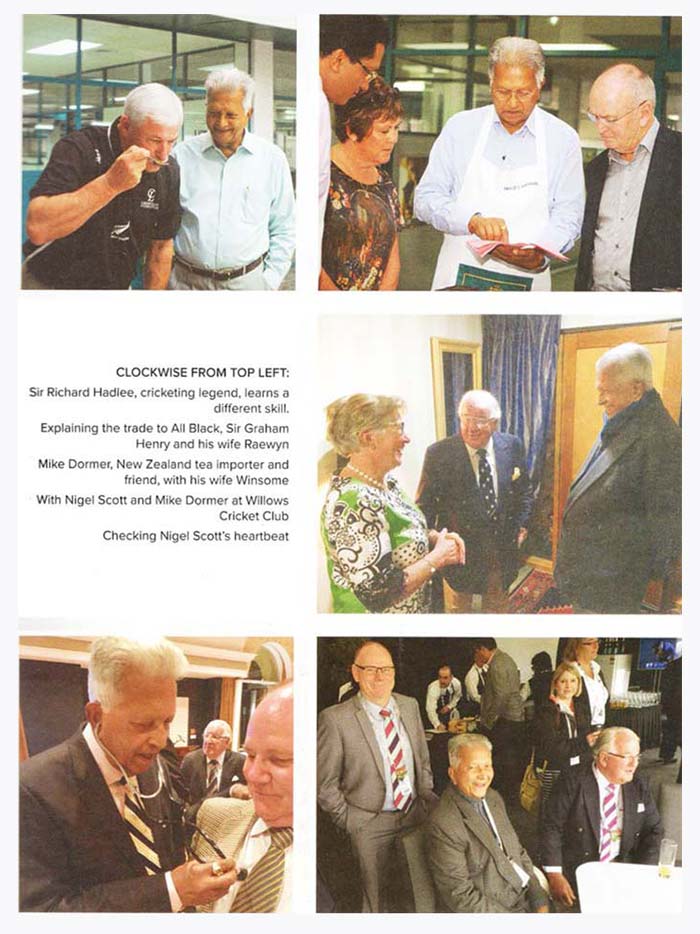
(Excerpted from the Merrill J. Fernando autobiography)
The success of my marketing platform in Australia produced interesting repercussions. When I made the claim that my single origin product stood apart from all others, as the latter were largely of cheap, multiple origins, the trade in Australia formed a new association called the Australian Tea Alliance. They invited the Dilmah distributor, Cerebos, to the first meeting and requested its representative to get me to attend the next.
I immediately divined their hidden agenda, which was to hobble my progress. Therefore, I advised Cerebos to tell the Chairman of this alliance, who was also the Chairman of a multinational in Australia, to send me a written invitation to join the alliance. I then received a letter from him, suggesting that we should establish a common promotional platform for tea, with the objective of increasing the general demand for tea and not for a particular brand. My response to him was that our objectives were mutually exclusive as, whilst his purpose was to sell any tea, mine was to market the finest tea on earth.
A few days later a senior member of the Australia-New Zealand Trade visited me in my hotel and again tried to persuade me to join the ‘alliance’. When I refused by saying that my mission was different to theirs, he responded that I would soon realize that I was making a mistake – a statement which was also an implied threat. Two weeks later I was informed by my distributor in Perth that a Dilmah consignment from Colombo had been confiscated by Customs in Perth. The reason? It was a chamomile herbal infusion marketed as restorative and a remedy for stomach ailments and that such claims were unsupportable.
Working with my lawyers, I found that a major competitor, Twinings, was making similar claims for its brand of chamomile tea. I sent a representational pack to the Melbourne Health Authority and found that it had approved it. When I confronted the official who stopped my shipment with this information, he advised me that there were powerful forces arraigned against me and that if I continued to fight this issue, my product would be barred from the supermarkets. Finally, I was compelled to recall that consignment of chamomile tea to Colombo, at a loss of USD 35,000. Shortly thereafter, the Chairman of the Australian Tea Alliance advised all supermarkets that I was making false claims about the exclusivity of my tea and that there was no difference between their product and mine, though they did not make such claims.
Through my lawyers I responded that their accusations were unfounded and that I was prepared to defend my position. Immediately, the Tea Alliance advised supermarket buyers that they did not mean to condemn Dilmah, but only sought to apprise them that my product was actually no better than theirs, though they made no such claim. That was a battle I had to fight entirely on my own as my distributor did not assist me.
Overall, in Australia, my experiences with distributors was unsatisfactory. My first distributor could not understand my marketing philosophy, because it was obviously quite different from that of all the other customers he serviced. My personal marketing system was based on direct contact with the buyer, and this distributor was not comfortable with that approach. I then moved to Cerebos Greggs, but the staff was inexperienced in the marketing of tea. These disappointing experiences finally compelled me to make my own marketing and distribution arrangements.
Dilmah in New Zealand
In New Zealand, I had been a bulk tea supplier to two major packers. One was Quality Packers Ltd., of which my good friend Pat Moore was the Chairman and Ian, the Chief Buyer. In the early days of my career in the tea trade, operating from Harrisons and Crossfield, Pat had been the Chief Buyer of Ceylon Tea for Salada Tea Company of Canada. The other was Well Tea Company, of which Trevor was the Chief Buyer. Pat’s buying from me was regular, whilst Trevor’s was intermittent and opportunistic.
Once, having been caught short of stock as he had not bought ahead despite my advice to buy Trevor persuaded me, on the promise of future regular buying, to send him four containers as I was the only supplier with reserve stock. However, despite that assurance, he continued to be an irregular buyer. In addition to these two, there were two or three other small-time operators.
When I decided to launch Dilmah in New Zealand, I first approached Balande, a French company, which unfortunately changed hands at that time. I then moved to a smaller operator, Nigel Scott, who at that time was not big enough to do justice to our brand. Jack and John Burton, who were selling my bulk tea in New Zealand, were not interested at first as they were unsure of the potential of Dilmah. I then approached other major players, Woolworths, Countdown, and Foodstuffs.
The latter, with about 60% of market share then, was very strong but it owned the Bell Tea brand. However, its buyer in Auckland, Shirley, was very receptive and agreed to provide me a warehouse, as she was impressed with the quality of our Ceylon Tea. Similarly, the other buyers and retailers we approached were equally welcoming and John Burton, both impressed and surprised by the responses, agreed to take on the distributorship. I subsequently met the Chairman of Foodstuffs who also agreed, enthusiastically, to support my brand. When I went back to Shirley to thank her for the facilitation, she regretfully declined to accept as her Chairman had sent her instructions not to touch Dilmah!
The fruits of perseverence
Despite these disappointments, my persistence and my faith, both in my brand and my God, paid off in New Zealand, as it had done elsewhere. The concept of the founder promoting his brand on television, radio, and magazines was an unusual, if not a unique marketing strategy, and attracted consumers to the brand. The media hype was reinforced solidly by an unwavering adherence to quality and every other attribute of the product that was advertised. The projected image of purity, singularity, and authenticity was complemented by the physical product. The slogan ‘Do Try It,’ backed by my image, was convincing in its simplicity. I used to get over 100 letters each month from satisfied customers, thanking me for bringing good Ceylon Tea, which they had enjoyed many years ago, back to the market.
From Australia and New Zealand, Dilmah gradually achieved a global reach and is now being sold in over 100 countries. It is the favourite brand of some of the best airlines and five-star hotels in the Asia-Pacific region. Emirates Airlines has carried Dilmah for 30 years. As a young tea trader, I carried my samples in my brief case in to the Albert Abela office in Sharjah and it was served on the airline in the very early stages.
That old association has now developed in to a unique relationship. In Emirates lounges the world over and in all its aircraft. Dilmah is the tea of choice. In December 2019, when Emirates Airlines launched the bar concept in its iconic Airbus 380, a special bar ceremony was held featuring Dilmah tea, at which within Dilhan and I were present. The launching of Dilmah tea 38,000 ft. in the air, between Dubai and London, celebrating the 27-year partnership between Dilmah and the airline, was an important event in the history of Dilmah tea.
With the growing popularity of Dilmah in Australia and New Zealand, I suddenly found myself becoming a celebrity! What caught the popular fancy of the public, as I mentioned earlier, was the concept of the founder personally selling his tea. Quite often I was referred to as “Mr. Dilmah”. I appeared in one of the most popular Australian TV programmes, ‘Home and Away,’ in a half-hour film on Dilmah and its founder. I was also featured on breakfast shows, whilst widely-read magazines ran three- to four-page articles with photographs.
In my media advertising of Dilmah in Australia, I went straight to the source instead of working through media agencies. With this direct approach I was able to work out how best to project exactly what I wanted. Quite apart from all other considerations, I think what captured the attention of the general public was the story of a small man from a small Asian country taking on the corporate giants in the West, in their own stronghold. That aspect of my marketing campaign generated a momentum of its own.
For over two years I struggled with the brand building of Dilmah in Australia and New Zealand. Eventually, despite all obstacles, legitimate competition, and sabotage, Dilmah restored the premier position of genuine Ceylon Tea in those countries. Whilst, after persistent struggles I was able to secure the help of the Tea Board for the promotion of a value-added, genuine Ceylon-owned brand, the Board, in a typical demonstration of the absence of both logic and awareness of priorities, was also funding the promotion of bulk tea being exported by one individual to Canada.
New Zealand is special
I have sold my Dilmah in over 100 countries. The travelling involved with the selling of my tea has enabled me to indulge in my passion for seeing new countries and experiencing new cultures, first kindled in my maiden visit overseas to the UK as young man in his early twenties. I have great memories of all the countries I have visited, the places I have seen, and the people I have befriended. However, nowhere else have I been so welcomed, or made to feel so much at home, as in New Zealand. I know that it is in New Zealand that I am best known and loved.
‘Do Try It,’ the words which have accompanied Dilmah across the globe, were born in New Zealand, when Daron Curtiss, Head of Waves Communications, then a small advertising agency in New Zealand, convinced me, despite my reservations, that the most effective way to convey my passion for tea was to tell the world personally. Until then. Australia-based Sri Lankan singer Kamahl had been the image and voice in the Dilmah advertisements. But Daron was so right in his alternative view to project me instead. That was in 1994 and Dilmah has been working with them ever since, whilst Daron and his wife Shirley have become my very dear friends. Establishing a connection with Daron and his company was serendipitous. I discovered them in the Yellow Pages!
Daron was hesitant initially on the grounds that he had minimal knowledge of the tea market but, providentially, as it has happened in every Important juncture of my life, the unseen hand intervened. Just a few weeks before my initial approach to Daron, Shirley had bought Dilmah tea from their local Howick supermarket. In itself a fortuitous incident, but from the first tasting itself they had become converts.
At first, I was doubtful of the effectiveness of Daron’s marketing strategy. After going through the shooting of the first commercial with Daron’s team I returned to Sri Lanka, having told him that if the strategy did not work, on my return to New Zealand I would have to find another advertising agency. On my next trip to NZ, a few months later, at the airport Customs counter, an officer looked up at me and said immediately: “You are that guy on TV.”
During the same trip, in another instance, as we got in to Daron’s car after a re-shoot of a Dilmah commercial, a few young people parked next to us rolled down their windows and yelled in unison, at the top of their voices, “Do try it!” That cleared all the doubts in my mind; Dilmah had arrived in New Zealand. Within a year of the broadcasting of the new Dilmah advertisement, Dilmah’s market share in New Zealand rose from below two to eight per cent.
The Curtiss family’s involvement with Dilmah went much further than advertising. In 2011, the Foundation unveiled the Daron Curtiss Centre for Graphic Design, at the MJF Centre in Moratuwa. Supported by Daron, this centre offers classes in graphic design to underprivileged children and young adults. Students include several who are physically handicapped, for whom competence in a highly-marketable skill opens a path for economic advancement and independence.
Perhaps it is the natural warmth of the New Zealanders that enables them to greet me so spontaneously, wherever I appear in public. People from diverse walks of life, sports icons, media personalities, chefs, bar tenders and waiters in hotels, and shoppers in supermarkets have stopped me to tell me that they like my Dilmah tea.
Iconic Kiwis, such as cricketing great Sir Richard Hadlee and the peerless All Black Sir Graham Henry, have personally supported projects launched by the MJF Charitable Foundation. A blindfolded Sir Hadlee, playing the forward defence against a cricket ball with a bell, in an engagement at the Moratuwa Centre with visually-handicapped cricketers of the Cricket Live Foundation, of which he is the patron, is an image that will endure.
The late Mike Dormer was another dear Kiwi, tea importer, and founder of the Willows Cricket Club, Christchurch, through whom several tours of the club cricket team to Sri Lanka were arranged. A reciprocal tour of a Sri Lankan, under 21 team, took place in 2011, playing five matches with NZ teams.
Nigel Scott, General Manager of Dilmah, New Zealand, who has been with Dilmah for 27 years, is another such friend. Richard Ballantyne, former Managing Director of J. Ballantyne and Company, is another Kiwi who has helped Dilmah in his country. Leighton Smith, the sophisticated but challenging voice which has dominated the airwaves of New Zealand morning radio for three decades, has given much airtime and helped to promote Dilmah. Along with his wife, Carolyn, he has been closely associated with the Dilmah journey in their country. They have also become close personal friends.
In his insightful personal memoir, ‘Leighton Smith, Beyond the Microphone,’ under the very flattering heading ‘The finest man on earth,’ he provides an unsolicited endorsement of my personal marketing ethos: “Without quality, especially in a competitive market like tea, all the advertising in the world will not build the sort of brand loyalty that Dilmah has. “
Sir Anand Satyanand, 19th Governor General of New Zealand (2006-2011), was also very supportive of the Dilmah promotion in New Zealand and continues to follow its progress closely. With his long involvement in and contribution to public interest issues and assignments, it was the aspect of the Dilmah commitment to social welfare, that captured his attention most. He and his wife Susan became great friends as well.
Features
The heart-friendly health minister

by Dr Gotabhya Ranasinghe
Senior Consultant Cardiologist
National Hospital Sri Lanka
When we sought a meeting with Hon Dr. Ramesh Pathirana, Minister of Health, he graciously cleared his busy schedule to accommodate us. Renowned for his attentive listening and deep understanding, Minister Pathirana is dedicated to advancing the health sector. His openness and transparency exemplify the qualities of an exemplary politician and minister.
Dr. Palitha Mahipala, the current Health Secretary, demonstrates both commendable enthusiasm and unwavering support. This combination of attributes makes him a highly compatible colleague for the esteemed Minister of Health.
Our discussion centered on a project that has been in the works for the past 30 years, one that no other minister had managed to advance.
Minister Pathirana, however, recognized the project’s significance and its potential to revolutionize care for heart patients.
The project involves the construction of a state-of-the-art facility at the premises of the National Hospital Colombo. The project’s location within the premises of the National Hospital underscores its importance and relevance to the healthcare infrastructure of the nation.
This facility will include a cardiology building and a tertiary care center, equipped with the latest technology to handle and treat all types of heart-related conditions and surgeries.
Securing funding was a major milestone for this initiative. Minister Pathirana successfully obtained approval for a $40 billion loan from the Asian Development Bank. With the funding in place, the foundation stone is scheduled to be laid in September this year, and construction will begin in January 2025.
This project guarantees a consistent and uninterrupted supply of stents and related medications for heart patients. As a result, patients will have timely access to essential medical supplies during their treatment and recovery. By securing these critical resources, the project aims to enhance patient outcomes, minimize treatment delays, and maintain the highest standards of cardiac care.
Upon its fruition, this monumental building will serve as a beacon of hope and healing, symbolizing the unwavering dedication to improving patient outcomes and fostering a healthier society.We anticipate a future marked by significant progress and positive outcomes in Sri Lanka’s cardiovascular treatment landscape within the foreseeable timeframe.
Features
A LOVING TRIBUTE TO JESUIT FR. ALOYSIUS PIERIS ON HIS 90th BIRTHDAY

by Fr. Emmanuel Fernando, OMI
Jesuit Fr. Aloysius Pieris (affectionately called Fr. Aloy) celebrated his 90th birthday on April 9, 2024 and I, as the editor of our Oblate Journal, THE MISSIONARY OBLATE had gone to press by that time. Immediately I decided to publish an article, appreciating the untiring selfless services he continues to offer for inter-Faith dialogue, the renewal of the Catholic Church, his concern for the poor and the suffering Sri Lankan masses and to me, the present writer.
It was in 1988, when I was appointed Director of the Oblate Scholastics at Ampitiya by the then Oblate Provincial Fr. Anselm Silva, that I came to know Fr. Aloy more closely. Knowing well his expertise in matters spiritual, theological, Indological and pastoral, and with the collaborative spirit of my companion-formators, our Oblate Scholastics were sent to Tulana, the Research and Encounter Centre, Kelaniya, of which he is the Founder-Director, for ‘exposure-programmes’ on matters spiritual, biblical, theological and pastoral. Some of these dimensions according to my view and that of my companion-formators, were not available at the National Seminary, Ampitiya.
Ever since that time, our Oblate formators/ accompaniers at the Oblate Scholasticate, Ampitiya , have continued to send our Oblate Scholastics to Tulana Centre for deepening their insights and convictions regarding matters needed to serve the people in today’s context. Fr. Aloy also had tried very enthusiastically with the Oblate team headed by Frs. Oswald Firth and Clement Waidyasekara to begin a Theologate, directed by the Religious Congregations in Sri Lanka, for the contextual formation/ accompaniment of their members. It should very well be a desired goal of the Leaders / Provincials of the Religious Congregations.
Besides being a formator/accompanier at the Oblate Scholasticate, I was entrusted also with the task of editing and publishing our Oblate journal, ‘The Missionary Oblate’. To maintain the quality of the journal I continue to depend on Fr. Aloy for his thought-provoking and stimulating articles on Biblical Spirituality, Biblical Theology and Ecclesiology. I am very grateful to him for his generous assistance. Of late, his writings on renewal of the Church, initiated by Pope St. John XX111 and continued by Pope Francis through the Synodal path, published in our Oblate journal, enable our readers to focus their attention also on the needed renewal in the Catholic Church in Sri Lanka. Fr. Aloy appreciated very much the Synodal path adopted by the Jesuit Pope Francis for the renewal of the Church, rooted very much on prayerful discernment. In my Religious and presbyteral life, Fr.Aloy continues to be my spiritual animator / guide and ongoing formator / acccompanier.
Fr. Aloysius Pieris, BA Hons (Lond), LPh (SHC, India), STL (PFT, Naples), PhD (SLU/VC), ThD (Tilburg), D.Ltt (KU), has been one of the eminent Asian theologians well recognized internationally and one who has lectured and held visiting chairs in many universities both in the West and in the East. Many members of Religious Congregations from Asian countries have benefited from his lectures and guidance in the East Asian Pastoral Institute (EAPI) in Manila, Philippines. He had been a Theologian consulted by the Federation of Asian Bishops’ Conferences for many years. During his professorship at the Gregorian University in Rome, he was called to be a member of a special group of advisers on other religions consulted by Pope Paul VI.
Fr. Aloy is the author of more than 30 books and well over 500 Research Papers. Some of his books and articles have been translated and published in several countries. Among those books, one can find the following: 1) The Genesis of an Asian Theology of Liberation (An Autobiographical Excursus on the Art of Theologising in Asia, 2) An Asian Theology of Liberation, 3) Providential Timeliness of Vatican 11 (a long-overdue halt to a scandalous millennium, 4) Give Vatican 11 a chance, 5) Leadership in the Church, 6) Relishing our faith in working for justice (Themes for study and discussion), 7) A Message meant mainly, not exclusively for Jesuits (Background information necessary for helping Francis renew the Church), 8) Lent in Lanka (Reflections and Resolutions, 9) Love meets wisdom (A Christian Experience of Buddhism, 10) Fire and Water 11) God’s Reign for God’s poor, 12) Our Unhiddden Agenda (How we Jesuits work, pray and form our men). He is also the Editor of two journals, Vagdevi, Journal of Religious Reflection and Dialogue, New Series.
Fr. Aloy has a BA in Pali and Sanskrit from the University of London and a Ph.D in Buddhist Philosophy from the University of Sri Lankan, Vidyodaya Campus. On Nov. 23, 2019, he was awarded the prestigious honorary Doctorate of Literature (D.Litt) by the Chancellor of the University of Kelaniya, the Most Venerable Welamitiyawe Dharmakirthi Sri Kusala Dhamma Thera.
Fr. Aloy continues to be a promoter of Gospel values and virtues. Justice as a constitutive dimension of love and social concern for the downtrodden masses are very much noted in his life and work. He had very much appreciated the commitment of the late Fr. Joseph (Joe) Fernando, the National Director of the Social and Economic Centre (SEDEC) for the poor.
In Sri Lanka, a few religious Congregations – the Good Shepherd Sisters, the Christian Brothers, the Marist Brothers and the Oblates – have invited him to animate their members especially during their Provincial Congresses, Chapters and International Conferences. The mainline Christian Churches also have sought his advice and followed his seminars. I, for one, regret very much, that the Sri Lankan authorities of the Catholic Church –today’s Hierarchy—- have not sought Fr.
Aloy’s expertise for the renewal of the Catholic Church in Sri Lanka and thus have not benefited from the immense store of wisdom and insight that he can offer to our local Church while the Sri Lankan bishops who governed the Catholic church in the immediate aftermath of the Second Vatican Council (Edmund Fernando OMI, Anthony de Saram, Leo Nanayakkara OSB, Frank Marcus Fernando, Paul Perera,) visited him and consulted him on many matters. Among the Tamil Bishops, Bishop Rayappu Joseph was keeping close contact with him and Bishop J. Deogupillai hosted him and his team visiting him after the horrible Black July massacre of Tamils.
Features
A fairy tale, success or debacle

Sri Lanka-Singapore Free Trade Agreement
By Gomi Senadhira
senadhiragomi@gmail.com
“You might tell fairy tales, but the progress of a country cannot be achieved through such narratives. A country cannot be developed by making false promises. The country moved backward because of the electoral promises made by political parties throughout time. We have witnessed that the ultimate result of this is the country becoming bankrupt. Unfortunately, many segments of the population have not come to realize this yet.” – President Ranil Wickremesinghe, 2024 Budget speech
Any Sri Lankan would agree with the above words of President Wickremesinghe on the false promises our politicians and officials make and the fairy tales they narrate which bankrupted this country. So, to understand this, let’s look at one such fairy tale with lots of false promises; Ranil Wickremesinghe’s greatest achievement in the area of international trade and investment promotion during the Yahapalana period, Sri Lanka-Singapore Free Trade Agreement (SLSFTA).
It is appropriate and timely to do it now as Finance Minister Wickremesinghe has just presented to parliament a bill on the National Policy on Economic Transformation which includes the establishment of an Office for International Trade and the Sri Lanka Institute of Economics and International Trade.
Was SLSFTA a “Cleverly negotiated Free Trade Agreement” as stated by the (former) Minister of Development Strategies and International Trade Malik Samarawickrama during the Parliamentary Debate on the SLSFTA in July 2018, or a colossal blunder covered up with lies, false promises, and fairy tales? After SLSFTA was signed there were a number of fairy tales published on this agreement by the Ministry of Development Strategies and International, Institute of Policy Studies, and others.
However, for this article, I would like to limit my comments to the speech by Minister Samarawickrama during the Parliamentary Debate, and the two most important areas in the agreement which were covered up with lies, fairy tales, and false promises, namely: revenue loss for Sri Lanka and Investment from Singapore. On the other important area, “Waste products dumping” I do not want to comment here as I have written extensively on the issue.
1. The revenue loss
During the Parliamentary Debate in July 2018, Minister Samarawickrama stated “…. let me reiterate that this FTA with Singapore has been very cleverly negotiated by us…. The liberalisation programme under this FTA has been carefully designed to have the least impact on domestic industry and revenue collection. We have included all revenue sensitive items in the negative list of items which will not be subject to removal of tariff. Therefore, 97.8% revenue from Customs duty is protected. Our tariff liberalisation will take place over a period of 12-15 years! In fact, the revenue earned through tariffs on goods imported from Singapore last year was Rs. 35 billion.
The revenue loss for over the next 15 years due to the FTA is only Rs. 733 million– which when annualised, on average, is just Rs. 51 million. That is just 0.14% per year! So anyone who claims the Singapore FTA causes revenue loss to the Government cannot do basic arithmetic! Mr. Speaker, in conclusion, I call on my fellow members of this House – don’t mislead the public with baseless criticism that is not grounded in facts. Don’t look at petty politics and use these issues for your own political survival.”
I was surprised to read the minister’s speech because an article published in January 2018 in “The Straits Times“, based on information released by the Singaporean Negotiators stated, “…. With the FTA, tariff savings for Singapore exports are estimated to hit $10 million annually“.
As the annual tariff savings (that is the revenue loss for Sri Lanka) calculated by the Singaporean Negotiators, Singaporean $ 10 million (Sri Lankan rupees 1,200 million in 2018) was way above the rupees’ 733 million revenue loss for 15 years estimated by the Sri Lankan negotiators, it was clear to any observer that one of the parties to the agreement had not done the basic arithmetic!
Six years later, according to a report published by “The Morning” newspaper, speaking at the Committee on Public Finance (COPF) on 7th May 2024, Mr Samarawickrama’s chief trade negotiator K.J. Weerasinghehad had admitted “…. that forecasted revenue loss for the Government of Sri Lanka through the Singapore FTA is Rs. 450 million in 2023 and Rs. 1.3 billion in 2024.”
If these numbers are correct, as tariff liberalisation under the SLSFTA has just started, we will pass Rs 2 billion very soon. Then, the question is how Sri Lanka’s trade negotiators made such a colossal blunder. Didn’t they do their basic arithmetic? If they didn’t know how to do basic arithmetic they should have at least done their basic readings. For example, the headline of the article published in The Straits Times in January 2018 was “Singapore, Sri Lanka sign FTA, annual savings of $10m expected”.
Anyway, as Sri Lanka’s chief negotiator reiterated at the COPF meeting that “…. since 99% of the tariffs in Singapore have zero rates of duty, Sri Lanka has agreed on 80% tariff liberalisation over a period of 15 years while expecting Singapore investments to address the imbalance in trade,” let’s turn towards investment.
Investment from Singapore
In July 2018, speaking during the Parliamentary Debate on the FTA this is what Minister Malik Samarawickrama stated on investment from Singapore, “Already, thanks to this FTA, in just the past two-and-a-half months since the agreement came into effect we have received a proposal from Singapore for investment amounting to $ 14.8 billion in an oil refinery for export of petroleum products. In addition, we have proposals for a steel manufacturing plant for exports ($ 1 billion investment), flour milling plant ($ 50 million), sugar refinery ($ 200 million). This adds up to more than $ 16.05 billion in the pipeline on these projects alone.
And all of these projects will create thousands of more jobs for our people. In principle approval has already been granted by the BOI and the investors are awaiting the release of land the environmental approvals to commence the project.
I request the Opposition and those with vested interests to change their narrow-minded thinking and join us to develop our country. We must always look at what is best for the whole community, not just the few who may oppose. We owe it to our people to courageously take decisions that will change their lives for the better.”
According to the media report I quoted earlier, speaking at the Committee on Public Finance (COPF) Chief Negotiator Weerasinghe has admitted that Sri Lanka was not happy with overall Singapore investments that have come in the past few years in return for the trade liberalisation under the Singapore-Sri Lanka Free Trade Agreement. He has added that between 2021 and 2023 the total investment from Singapore had been around $162 million!
What happened to those projects worth $16 billion negotiated, thanks to the SLSFTA, in just the two-and-a-half months after the agreement came into effect and approved by the BOI? I do not know about the steel manufacturing plant for exports ($ 1 billion investment), flour milling plant ($ 50 million) and sugar refinery ($ 200 million).
However, story of the multibillion-dollar investment in the Petroleum Refinery unfolded in a manner that would qualify it as the best fairy tale with false promises presented by our politicians and the officials, prior to 2019 elections.
Though many Sri Lankans got to know, through the media which repeatedly highlighted a plethora of issues surrounding the project and the questionable credentials of the Singaporean investor, the construction work on the Mirrijiwela Oil Refinery along with the cement factory began on the24th of March 2019 with a bang and Minister Ranil Wickremesinghe and his ministers along with the foreign and local dignitaries laid the foundation stones.
That was few months before the 2019 Presidential elections. Inaugurating the construction work Prime Minister Ranil Wickremesinghe said the projects will create thousands of job opportunities in the area and surrounding districts.
The oil refinery, which was to be built over 200 acres of land, with the capacity to refine 200,000 barrels of crude oil per day, was to generate US$7 billion of exports and create 1,500 direct and 3,000 indirect jobs. The construction of the refinery was to be completed in 44 months. Four years later, in August 2023 the Cabinet of Ministers approved the proposal presented by President Ranil Wickremesinghe to cancel the agreement with the investors of the refinery as the project has not been implemented! Can they explain to the country how much money was wasted to produce that fairy tale?
It is obvious that the President, ministers, and officials had made huge blunders and had deliberately misled the public and the parliament on the revenue loss and potential investment from SLSFTA with fairy tales and false promises.
As the president himself said, a country cannot be developed by making false promises or with fairy tales and these false promises and fairy tales had bankrupted the country. “Unfortunately, many segments of the population have not come to realize this yet”.
(The writer, a specialist and an activist on trade and development issues . )


